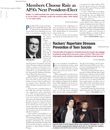Let the sun shine in and melt your troubles away.
This piece of advice may sound like a hokey song refrain or a plug from a resort advertisement. But a new study suggests that there may be something to it.
The study found that postsurgery patients experienced less psychological stress and pain, and used less pain medication, when housed on the sunny side of the hospital.
The investigation was headed by Jeffrey Walch, an M.D.-Ph.D. candidate and medical researcher at the University of Pittsburgh. Walch was an architect major in college and is interested in how architectural design and environmental factors might affect patient recovery in the hospital.
It is well documented that light can counter seasonal affective disorder, but other studies have suggested that light can positively affect hospital patients. For example, light exposure has been linked to a reduced hospital stay for heart-attack patients.
Still other findings have indicated that light can increase the concentration of the neurotransmitter serotonin and that serotonin in turn can inhibit pain pathways in the central nervous system.
So Walch and colleagues at the University of Pittsburgh and Carnegie Mellon University decided to see whether sunlight might favorably impact hospital patients' stress perception, pain perception, and pain-medication use.
They enrolled 89 subjects who were about to undergo spinal surgery. Forty-four had been housed on the sunny side of the hospital and 45 on the shady side of the hospital simply on the basis of room availability. However, Walch and his team made sure that subjects housed on the sunny side did not differ significantly from the other subjects on demographics, clinical diagnosis, surgical procedure, use of pain medication before hospitalization, use of pain medication in the operating room, and use of pain medication in the postanesthesia care unit.
Sunlight Intensity Assessed
Once subjects were moved from the postanesthesia care unit to a hospital room, and until their discharge from the hospital, the researchers measured daily sunlight intensity in their hospital rooms.
They measured daily sunlight intensity in a subject's room as follows:
Five times in the morning and five times in the afternoon, they measured direct sunlight in the room (the intensity of sunlight at the point where it entered the room); reflective sunlight (the intensity of sunlight reflected off the patient); and ambient sunlight (the intensity of sunlight reflected off interior surfaces). Direct, reflective, and ambient sunlight intensity results for the morning were then averaged. The same was done for direct, reflective, and ambient sunlight intensity results for the afternoon. Results for the morning were then multiplied by the number of morning hours, and results for the afternoon were multiplied by the number of afternoon hours. The total sunlight intensity results for the morning and the afternoon were then added, giving the cumulative sunlight intensity for the day.
Using these yardsticks, the investigators found that subjects on the sunny side of the hospital were exposed to 46 percent greater-intensity sunlight on average than were subjects on the shady side.
Pain, Stress Evaluated
Upon discharge from the postanesthesia care unit and from the hospital, subjects filled out four questionnaires—the Profile of Mood States anxiety scale, Center for Epidemiological Studies Depression Scale, Perceived Stress Scale, and McGill Pain Questionnaire.
These instruments allowed the researchers to determine how subjects' anxiety, depression, perceived stress, and perceived pain on discharge from the postanesthesia care unit compared with those factors on discharge from the hospital, and also how the sunny and shady groups compared.
Subjects on both the sunny and shady sides experienced comparable levels of anxiety, depression, stress, and pain upon discharge from the postanesthesia care unit. They also experienced comparable levels of anxiety and depression upon hospital discharge, and these levels were similar to what they had experienced upon discharge from the postanesthesia care unit.
However, stress levels at hospital discharge were found to be significantly lower in the sunny-room group than in the shady-room group. And the sunny-room group's stress levels were lower at hospital discharge than at the time of discharge from the postanesthesia care unit, but this was not the case for the shady-room group.
With regard to pain, both groups reported less upon hospital discharge than after discharge from the postanesthesia care unit, but the sunny-room group reported considerably less pain than the shady-room group.
Subjects were also evaluated for the amount of pain medication they had used during hospitalization.
The sunny-room group was found to have used 22 percent less pain medication than the other group had.
“I was happy with the results,” Walch told Psychiatric News. “I think that the subject will be investigated further and that it may impact the hospital design of the future. But I was surprised that we didn't just show a decrease in stress, but also a decrease in pain perception and a decrease in pain-medication usage.”
Still another surprise, Walch said, was that while the sunny-room group experienced significantly less stress at hospital discharge, it was not statistically linked with the sunny-room group's lower levels of analgesic use. So he does not believe that subjects' decreased pain medication use resulted from having less psychological stress. “They are separate outcomes,” he said.
The study was funded by the University of Pittsburgh Medical Center Healthy Lifestyle Program and a grant from Carnegie Mellon University's Undergraduate Research Initiative. Results were published in the January-February Psychosomatic Medicine.
An abstract of the report, “The Effect of Sunlight on Postoperative Analgesic Medication Use: A Prospective Study of Patients Undergoing Spinal Surgery,” is posted online at<www.psychosomaticmedicine.org/cgi/content/abstract/67/1/156>.▪
Psychosom Med 2005 1 156
